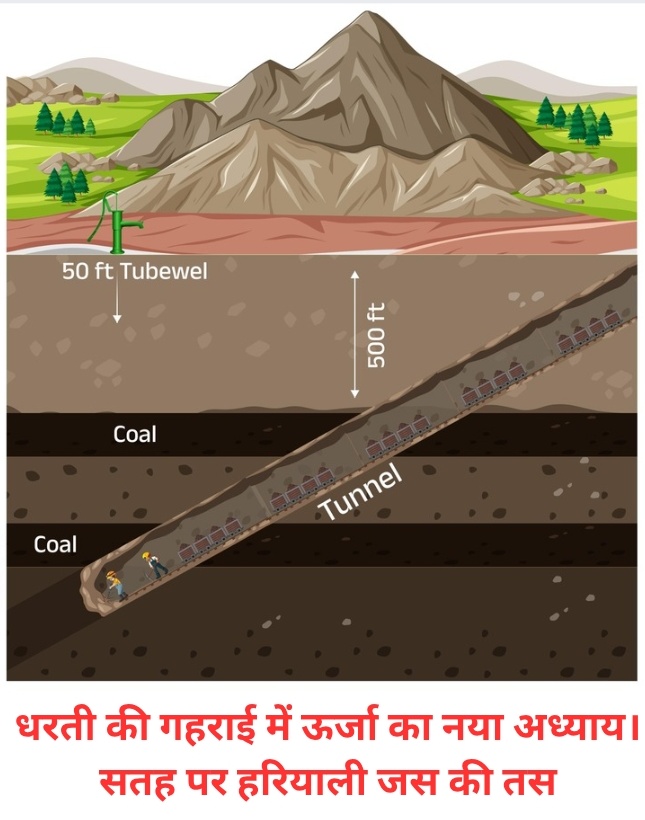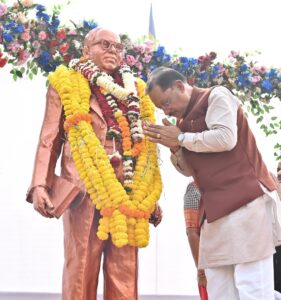Proposed Purunga underground coal mine in Raigarh set to produce 2.25 million tonnes annually, powering India’s energy self-reliance vision

👷♂️Purunga mine to blend energy production with environmental protection
👷♂️ Surface land, forests and water sources to remain unaffected
👷♂️New livelihood opportunities for local communities
👷♂️Chhattisgarh to reinforce its pivotal role in India’s energy growth
By : Akshay Lahre
Raigarh/Raipur ।। India today stands at a decisive juncture in its journey toward energy self-reliance. As the world battles the twin challenges of resource scarcity and environmental degradation, India has chosen a balanced path that integrates progress with preservation. In this context, underground coal mining has emerged as the next frontier in sustainable energy extraction. A shining example of this approach is the proposed Purunga Underground Coal Mine in Raigarh district of Chhattisgarh, envisioned as a landmark project in responsible and eco-sensitive development.
The Purunga mine is being developed with an annual production capacity of 2.25 million tonnes. According to the Ministry of Coal, Government of India, underground mining offers a way to meet growing energy demands while protecting the environment, biodiversity and social balance. The Ministry’s recent statement emphasized that “underground mining enables the extraction of resources deep within the earth without disturbing surface ecosystems, farmlands or forests.”
*Energy beneath, greenery above*
The Purunga project is designed and engineered as per international safety and environmental benchmarks. Mining operations will take place at depths ranging between 500 and 2000 feet. No surface excavation or blasting will occur, ensuring complete protection for farms, trees, vegetation, and nearby settlements. Experts affirm that underground mining does not affect soil fertility or traditional cropping patterns, making it a practical and sustainable choice for mineral-rich regions like Chhattisgarh.
*A safe model for wildlife and biodiversity*
Concerns about wildlife disturbance are common with mining activities, but underground mining stands apart. Since heavy surface machinery and explosives are not required, there is minimal disruption to elephant corridors, deer habitats, fox burrows or bird nesting zones. Environmental specialists note that “underground coal extraction allows energy recovery without compromising natural habitats, setting a benchmark for eco-sensitive industrial operations.”
*Cleaner air, quieter surroundings*
Compared to open-cast mining, underground operations significantly reduce dust, smoke and noise pollution. Coal dust remains confined underground, keeping the air around nearby villages cleaner. Vibrations and heavy truck movements are negligible. Moreover, the water that emerges during mining will be treated through advanced filtration systems and supplied for community use, creating a circular model of resource utilization.
*Water and soil balance intact*
In rural areas, tube wells usually reach only 40 to 50 feet deep, while coal seams in the Purunga block lie well below 500 feet. This natural separation ensures no adverse impact on groundwater. As the topsoil remains undisturbed, agricultural productivity continues unhindered. Each stage of drainage and soil management is guided by scientific safeguards to preserve the integrity of the ecosystem.
*Local prosperity and inclusive growth*
The Purunga underground mine is expected to open new avenues of employment for local youth through both direct and indirect opportunities. Ancillary sectors such as transport, machinery maintenance and services will also benefit. The project’s Corporate Social Responsibility initiatives will focus on upgrading education, healthcare, drinking water and rural infrastructure. Local panchayats are slated to play a participatory role in monitoring and community welfare.
*Dialogue over dissent*
A few apprehensions have surfaced regarding land acquisition and ecological impact. However, subject-matter experts insist that “underground mines are far more sustainable and socially acceptable than open-cast operations.” Hence, public discourse around such projects must be guided by facts, science, and long-term national interests rather than by speculation or misinformation.
Chhattisgarh’s contribution to India’s energy mission
Chhattisgarh contributes nearly 20 percent of India’s total coal output. The Purunga mine will further strengthen this contribution, advancing industrial growth and fortifying the country’s energy backbone. It represents a vital stride toward Prime Minister Narendra Modi’s vision of Atmanirbhar Bharat, a self-reliant India powered by responsible energy practices.
*Sustainable development, the Indian way*
The rise of underground mining in India demonstrates that progress need not come at the cost of nature. A senior Coal Ministry official summed it up aptly: “Underground mining reflects India’s evolving energy future, where development and ecology move forward together.”
The Purunga underground coal mine is more than a mining project; it is a model of harmony between technology and nature, between human aspiration and environmental stewardship. It stands as a testament to India’s resolve to harness the earth’s depths without wounding its surface.
That, ultimately, is the new Indian paradigm of progress: growth with greenery, energy with equilibrium.







